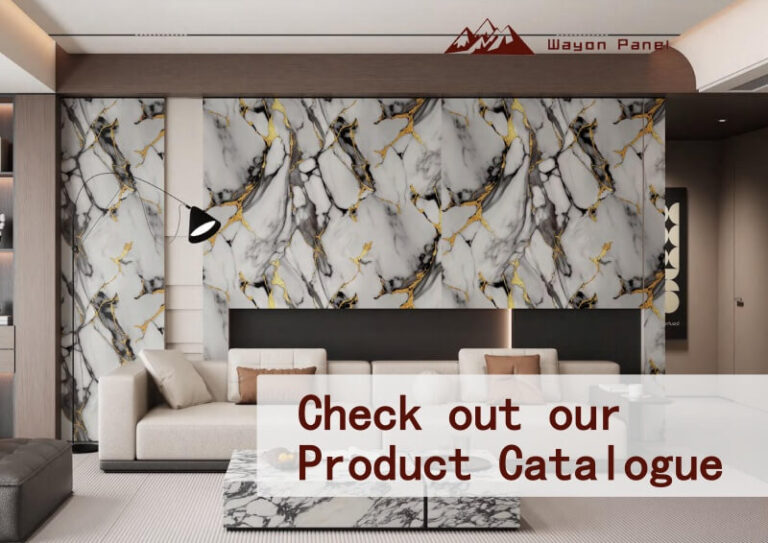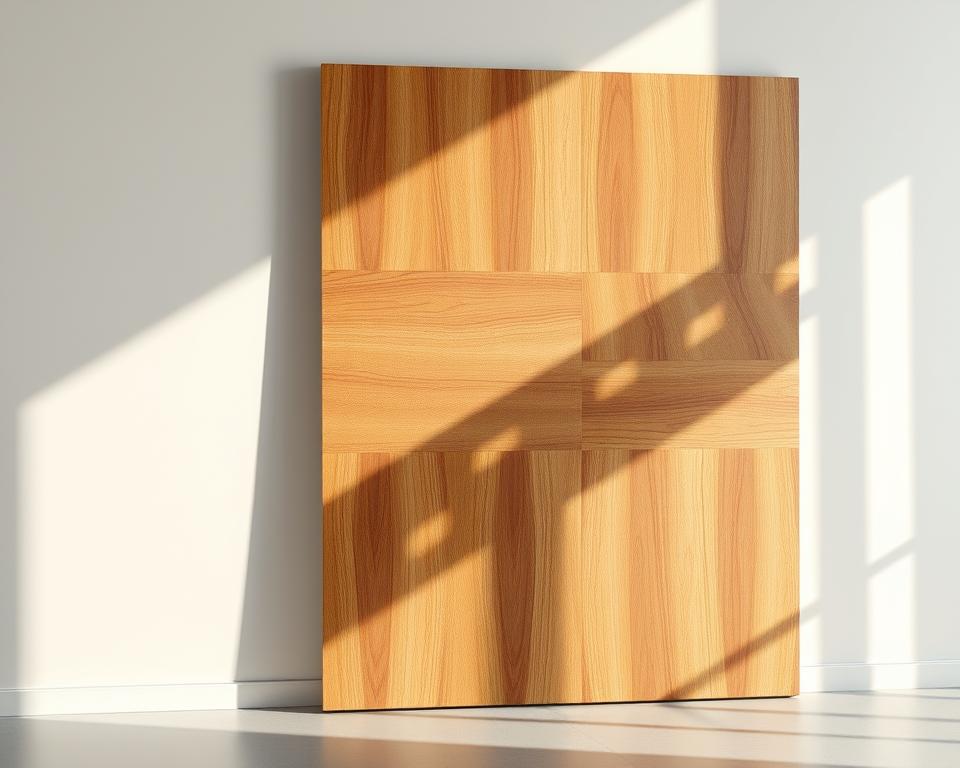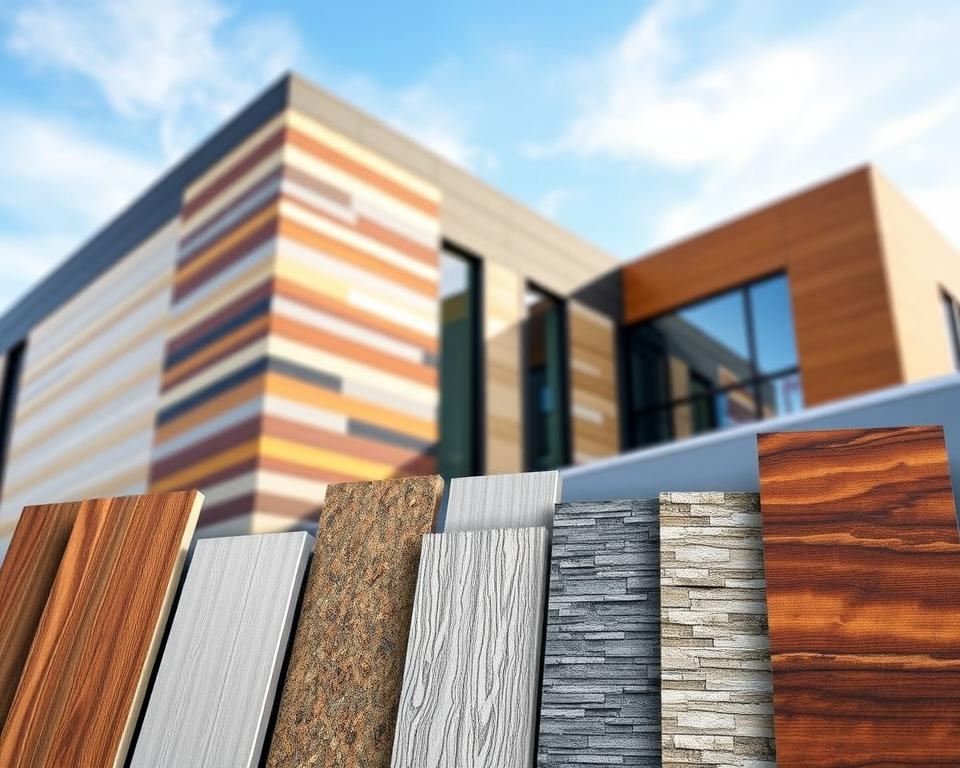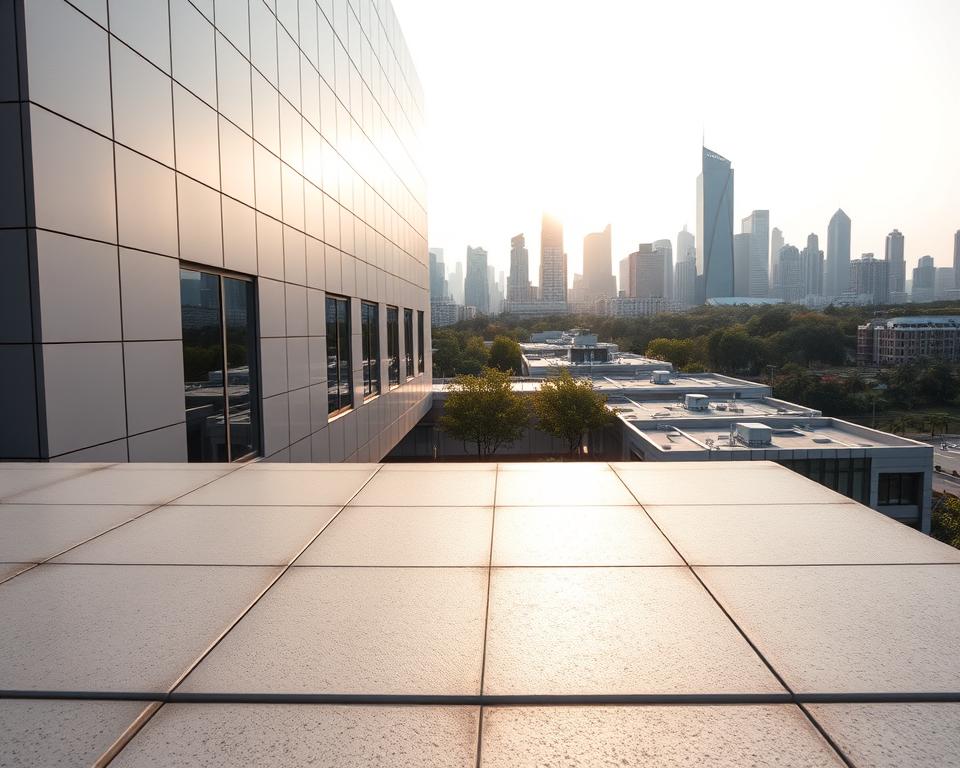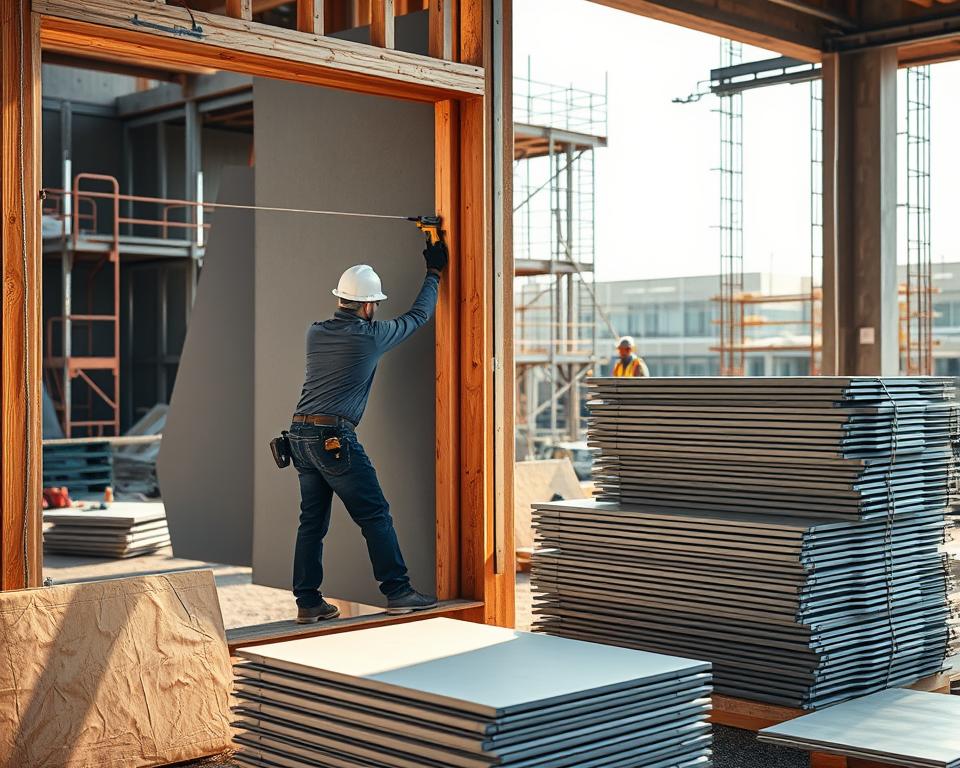Choosing the right partner for construction materials can make or break your project. In today’s fast-paced market, builders and property owners need suppliers that combine technical know-how with reliable service. The stakes are high—subpar materials or delays can lead to costly repairs or missed deadlines.
Leading companies stand out through three core strengths: advanced engineering capabilities, premium-grade materials, and responsive support teams. These elements ensure panels meet structural demands while aligning with design goals. For example, a firm’s ability to customize product dimensions or finishes often separates it from competitors.
Your selection directly affects a building’s lifespan and maintenance costs. High-performance solutions resist weathering, fading, and impact—critical for both commercial complexes and residential spaces. Over 60% of U.S. contractors now prioritize suppliers offering extended warranties, reflecting the emphasis on long-term value.
This guide breaks down essential evaluation criteria, from eco-friendly production methods to post-installation services. With the U.S. market for advanced cladding options growing by 12% annually, informed decisions are more vital than ever. You’ll learn how to spot manufacturers that balance innovation with practical reliability.
By the end, you’ll have a clear roadmap to identify partners who deliver durable, visually appealing results. Let’s explore what separates industry leaders from the rest.
Overview of Composite Wall Panel Solutions
The backbone of any durable structure lies in the quality of its cladding solutions. Modern builders now rely on engineered materials that merge strength with visual versatility. These products typically feature a polyethylene core layered between weather-resistant surfaces, creating lightweight yet robust systems.
Introduction to Composite Wall Panels
Unlike traditional wood or metal options, these multi-layered panels resist warping, rust, and fading. Their layered design allows for customized textures and colors, meeting both functional and aesthetic needs.
Market Trends and US Industry Insights
Demand for advanced cladding has surged by 14% since 2022, driven by commercial renovations and eco-friendly housing projects. Over 45% of architects now specify these systems for high-traffic areas due to their low upkeep. A recent industry news report highlights their growing application in coastal developments, where saltwater resistance is critical.
| Feature | Modern Panels | Traditional Materials |
|---|---|---|
| Lifespan | 25+ years | 10-15 years |
| Maintenance | Annual cleaning | Seasonal repairs |
| Design Options | 40+ finishes | 5-8 standard choices |
Residential projects account for 38% of recent orders, with homeowners favoring wood-plastic composite (WPC) options for garden facades. Developers praise the 70% reduction in installation time compared to brick or stone.
Understanding the Benefits of Composite Wall Panels
Builders today prioritize solutions that deliver lasting performance while reducing environmental impact. These engineered systems excel in both resilience and eco-efficiency, making them ideal for projects where longevity matters.
Durability and Weather Resistance
WPC cladding withstands extreme conditions effortlessly. Its waterproof core prevents swelling in heavy rain, while fire-resistant layers meet strict safety codes. Coastal developers particularly value its saltwater corrosion resistance—a feature that keeps facades intact for over two decades.
One contractor noted: “After switching to these materials, we saw a 90% drop in weather-related callbacks.” This reliability stems from advanced polymer blends that repel insects and resist UV fading.
Sustainability and Low Maintenance
Made with recycled plastics and reclaimed wood fibers, these products divert waste from landfills. Their smooth surfaces need only occasional rinsing—no seasonal sanding or repainting. Compared to traditional timber, they eliminate annual sealing costs and reduce water usage during cleaning by 75%.
- No chemical treatments required
- 40% faster installation than natural wood
- 20-year lifespan with minimal upkeep
A 2023 industry report highlighted their role in achieving LEED certification, with architects praising their balance of eco-friendliness and practicality.
Key Features of a Composite Wall Panel Manufacturer
Advanced production methods separate industry leaders from average suppliers. Top-tier firms invest in cutting-edge technologies that ensure every component meets exact specifications. This focus on technical excellence directly translates to faster project timelines and fewer on-site adjustments.
Precision Fabrication Techniques
Computer-controlled routing equipment carves panels with millimeter accuracy, ensuring seamless alignment during installation. Staggered angle clips built into each unit allow contractors to make micro-adjustments, simplifying complex facade layouts.
Consistent quality across large orders hinges on three factors:
- Automated calibration checks every 90 minutes
- Real-time thickness monitoring systems
- Batch testing for impact resistance
| Aspect | Standard Methods | Precision Fabrication |
|---|---|---|
| Dimensional Accuracy | ±3 mm tolerance | ±0.5 mm tolerance |
| Custom Design Options | Limited profiles | 60+ configurations |
| Production Speed | 40 panels/hour | 85 panels/hour |
This approach maintains cost efficiency while accommodating unique architectural demands. A project guide from Denver’s Skyline Tower renovation shows how custom-curved panels reduced installation labor by 35% compared to traditional methods.
Regular audits of fabrication lines prevent defects, with rejected units immediately recycled. Such measures explain why leading suppliers offer 25-year warranties – their process eliminates variables that cause premature wear.
Advanced Manufacturing Processes and Material Innovations
Modern construction demands precision engineering that pushes material science forward. Leading producers now combine cutting-edge fabrication methods with rigorously tested formulas to create cladding systems that outperform conventional options.
State-of-the-Art Routing and Panel Fabrication
Thermobonding technology fuses protective .020 aluminum skins to core layers under controlled heat. This process creates unbreakable molecular bonds, eliminating gaps where moisture could penetrate. Computer-guided routers then shape panels with 0.2mm accuracy—tighter than a credit card’s thickness.
| Feature | Traditional Methods | Advanced Routing |
|---|---|---|
| Edge Precision | Visible seams | Seamless joints |
| Production Rate | 50 units/hour | 120 units/hour |
| Waste Reduction | 15% material loss | 4% material loss |
Material Composition and Quality Assurance
Our series uses a 55% wood fiber blend reinforced with high-density polyethylene (HDPE). Special additives enhance UV resistance and prevent thermal expansion. Fire-retardant cores undergo third-party testing, withstanding 2,000°F flames for 90 minutes.
- X-ray scanners detect density variations
- Batch samples tested for impact resistance
- 30-point inspection before packaging
One production manager notes: “Our recycling systems reprocess 98% of manufacturing scrap into new panels.” This closed-loop approach meets strict environmental standards while maintaining structural integrity.
Design Flexibility and Customization Options
Architects and developers increasingly demand materials that adapt to bold visions rather than limit creativity. Modern cladding systems now offer unprecedented artistic freedom while maintaining structural integrity.
Diverse Color, Finish, and Texture Choices
Leading suppliers provide over 60 curated hues, from muted earth tones to vibrant custom shades. Wood-plastic options replicate teak grain patterns so accurately that even contractors struggle to distinguish them from natural timber. Metal-based systems come in brushed metallic finishes ideal for tech campuses or sleek urban facades.
| Feature | Modern Options | Traditional Choices |
|---|---|---|
| Available Colors | 60+ (custom blends) | 8-12 standard |
| Texture Variety | 15+ patterns | 3 basic options |
| Fade Resistance | 25-year warranty | 5-year average |
A Seattle architect notes: “We matched a client’s brand Pantone exactly across 12,000 square feet of facade—zero variation between batches.” This precision stems from automated tinting systems that maintain ±0.3% color consistency.
Retail spaces benefit particularly from this versatility. Coffee shop chains use warm walnut finishes for cozy interiors, while medical centers opt for sterile white surfaces. UV-resistant coatings ensure hues stay true despite decades of sun exposure.
Advanced lamination techniques allow mixing textures within single panels. Contractors might combine smooth upper sections with embossed lower areas for visual depth. Such features help properties stand out in competitive markets without compromising durability.
Weather Resistance and Long-Term Durability
Extreme weather tests building materials like nothing else. Modern cladding systems must survive decades of rain, heat waves, and freezing temperatures while keeping their looks intact. This is where engineered alternatives outshine conventional options through smart material science.
Moisture, Fire, and Corrosion Resistance
High-performance options laugh at challenges that destroy natural wood. Their waterproof cores block swelling during floods, while fire-retardant layers meet strict ASTM E84 Class A ratings. Unlike untreated timber, these materials don’t:
- Warp in humid climates
- Harbor termites or mold
- Rust near coastal salt air
| Feature | Engineered Materials | Natural Wood |
|---|---|---|
| Water Absorption | 0.5% max | 12-18% |
| Fire Resistance | Self-extinguishing | Rapid ignition |
| Salt Air Durability | 25+ years | 5-7 years |
Performance Under Harsh Weather Conditions
Florida contractors recently installed these systems on beachfront condos. “After three hurricane seasons,” one project manager noted, “zero warping or fading—even units facing direct sunlight look new.” Built-in UV blockers prevent color loss, while thermal-stable formulas handle -40°F to 120°F swings.
Snowbelt regions benefit from ice-resistant surfaces that shed heavy buildup. Midwest developers report 80% fewer winter damage claims compared to vinyl siding. With proper installation, these solutions reliably hit their 20-year service life with just annual rinses.
Installation, Maintenance, and Cleaning Ease
Streamlined installation separates exceptional cladding systems from mediocre alternatives. Modern solutions simplify assembly through intuitive designs that reduce labor costs and errors. Contractors increasingly favor methods requiring basic tools rather than specialized equipment.
Simplified Installation Processes
Staggered angle clips revolutionize mounting by letting workers adjust each unit independently. This precision eliminates alignment headaches common with traditional methods. A project manager in Arizona noted: “We completed a 15,000 sq. ft. facade two days faster using these adjustable systems.”
Rain-screen designs like our products remove caulking needs through strategic airflow channels. These gaps prevent moisture buildup while maintaining sleek visual lines. Free-floating assemblies accommodate building shifts from temperature changes without stress cracks.
| Feature | Traditional Installation | Modern Approach |
|---|---|---|
| Adjustment Time | 45 min/panel | 8 min/panel |
| Required Tools | 7+ specialized | 3 standard |
| Weather Protection | Caulk-dependent | Built-in drainage |
Field modifications become straightforward with materials that cut like natural wood. Contractors use ordinary saws to resize units on-site, adapting to last-minute design changes. Maintenance proves equally simple—most stains wipe off with water, and surfaces never need repainting.
Annual cleaning involves basic rinsing, saving 80% of upkeep time compared to painted alternatives. Hotels and schools particularly benefit from this low-effort care, maintaining pristine appearances year-round.
Sustainability and Environmental Impact in Composite Panels
Green building practices are reshaping material selection across the U.S. construction sector. Forward-thinking firms now prioritize solutions that reduce ecological footprints without sacrificing performance. These efforts align with global sustainability goals while meeting stricter building codes.
Eco-friendly Materials and Processes
Innovative production methods transform waste into high-value building products. Wood-plastic blends combine FSC-certified timber fibers with post-consumer plastics like polyethylene. One factory manager explains: “Our process repurposes 2.8 million plastic bags daily—equivalent to clearing 14 football fields of landfill waste.”
| Feature | Traditional Materials | Sustainable Alternatives |
|---|---|---|
| Recycled Content | 0-15% | 60-95% |
| Certifications | Basic safety tests | FSC, CE, LEED |
| Carbon Footprint | 8.2 kg CO2/m² | 2.1 kg CO2/m² |
Recycled Components and Renewable Resources
Leading producers source 40% of their polyethylene from milk jugs and detergent bottles. Combined with fast-growing pine fibers, these inputs create durable surfaces that outperform virgin plastics. Third-party audits verify every batch meets strict eco-standards.
Key environmental benefits include:
- 72% less manufacturing waste than vinyl
- 30-year lifespan with 100% recyclability
- LEED credit eligibility for commercial projects
Application Insights: Commercial, Residential, and More
From sleek urban storefronts to cozy suburban homes, modern construction requires materials that adapt to diverse needs. Engineered cladding systems now serve multiple roles across industries, proving their worth in both form and function.
Adapting to Modern Construction Demands
These systems shine in projects ranging from garden fences to 40-story office towers. A Phoenix-based contractor recently transformed a 1960s strip mall using textured finishes that mimic weathered wood. “We cut installation time by half compared to traditional stone,” they noted.
| Project Type | Key Features | Common Uses |
|---|---|---|
| Residential | Weather-resistant surfaces | Balconies, facades |
| Commercial | Noise-dampening cores | Office partitions |
| Retail | Custom color matching | Storefront branding |
Real-World Success Stories
Seattle’s Greenlake Shopping Center used interlocking units to revamp its exterior during peak tourist season. The lightweight design allowed work without closing stores. Thermal-efficient options helped a Boston co-working space reduce HVAC costs by 18%.
Key technical factors for different settings:
- Wind load ratings for coastal areas
- Fire codes for multi-family units
- Slip resistance in poolside installations
Supplier Reliability: Warranty, Support, and Custom Orders
Trust forms the foundation of successful building projects. Partners who stand behind their products with clear guarantees and adaptable solutions prove invaluable over time. This final guide highlights how to assess a provider’s commitment beyond initial sales.
Comprehensive Warranty and Customer Support
Coverage typically includes defects in color retention, structural integrity, and weather resistance. Round-the-clock technical support ensures quick resolution of installation queries.
Ordering, Samples, and Custom Design Options
Most firms offer free material samples, though shipping fees often apply. Minimum order quantities start at 200sqm for decking boards, allowing smaller contractors to test systems. Customization shines through:
- Color matching within 72 hours
- Textured finishes mimicking natural wood grain
- Specialty board dimensions for unique layouts
Prioritize companies providing detailed installation guides and real-time order tracking. These elements transform complex projects into streamlined processes, ensuring your vision becomes reality without costly surprises.

